When it comes to food allergies, anyone can have them and they’re not dependent on family history. In addition, only about 2-3% of children under three years of age are found to have peanut, egg, and milk allergies, according to the Prevent Allergies Organization.
For first-time parents, or even parents who have been around the block a few times, introducing your baby to foods associated with allergens is a scary and overwhelming process. However, introducing these foods early on in life can significantly reduce the risk of developing certain food allergies by up to 80% in infants.
“Babies should be introduced to foods classically thought of as allergens around six months of age, [but] not before four months of age,” says Dr. Scott H. Sicherer, M.D., professor of Pediatric Allergy and Immunology, and the author of The Complete Guide to Food Allergies in Adults and Children “But over the last several years, the recommendations have been quite the opposite,” he explains.
It’s best for allergens to be introduced early on in a child’s life—among the normal foods typically fed to infants—as in some cases, it may even help prevent allergies in the future and/or reveal any severe reactions that are good to catch early on. Dr. Sicherer recommends parents stop, “treating foods possibly thought of as allergens differently than any other food.”
With all of this in mind, we asked the experts how to best help you understand and prepare for the day you start giving your baby foods that could contain allergens. These are the seven tips and tricks to properly, safely, and effectively introduce kids to allergens.


Step one, as we’ve discussed above, is to bring allergen foods into the equation as early as possible. After babies reach the four- to six-month range, you’ll be able to appropriately examine their reactions to food outside of breastfeeding and/or formula. But what foods does this include exactly?
Foods that may cause an allergic reaction or intolerance are those that are or contain milk, egg, wheat, soy/soybeans, peanut, tree nuts, fish (mainly shellfish), and sometimes even sesame seeds. “It’s OK for babies to be introduced to these things that are sort of allergens. And it might be even better to have it among the earlier foods they’re introduced to,” Dr. Sicherer says.
Multiple studies and reviews have found that introducing allergens to infants within the beginning of their first year (4-6 months) combats the development of allergies to food as the child grows up. It’s also possible that if the process is delayed for too long, then there’s a greater chance that a child can become allergic or more sensitive to common allergy-related foods.
“The introduction of peanut, for example, is generally recommended around six months of age, [and] not before four months,” Dr. Sicherer explains. But, he says, “for babies showing signs of allergy, it might actually be given earlier in that four to six months window of time.” Early attempts can allow parents to see any physical discomfort, and allergies can be spotted and then dealt with quickly (and possibly even before they reach a severe level).
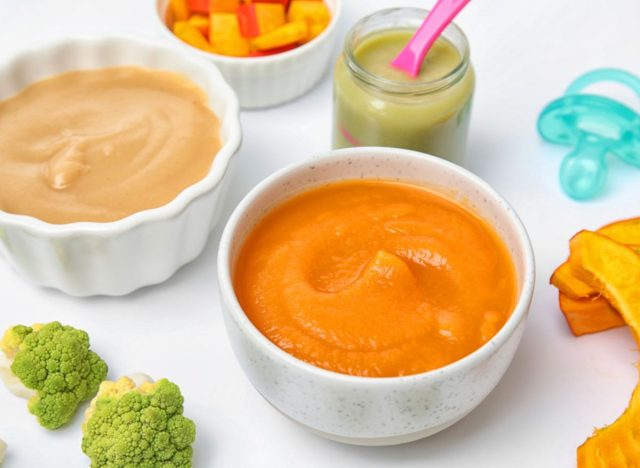

This is one of the easiest tips to stick to. Don’t start giving your child any foods they’re not ready to consume yet. While you may be concerned about how your child will react to certain foods, “we have to take into consideration the baby’s ability to eat solids,” Dr. Sicherer explains.
“Some babies are ready for solids and they’re able to take those pureed foods and keep it fine,” he says, “others might dribble it out and not be ready yet.” Once infants begin to wean off of liquids as their only forms of nourishment—which can be past the six-month period in some cases—then it’s officially time to start introducing allergen foods.
Although, there are right ways and wrong ways to go about this first-time experience. You’re definitely not going to want to try giving a baby whole peanuts as their first go-around, because they can and will choke, Dr. Sicherer explains. Along with pieces of nuts, “peanut butter is a choking hazard for babies” he says.
As you feel out when your child becomes ready to take on solid foods, they should be presented in a safe matter. This is going to be foods that are in the form of purees, pastes, sauces, and (for some of the fast learners) tiny pieces that don’t require chewing.
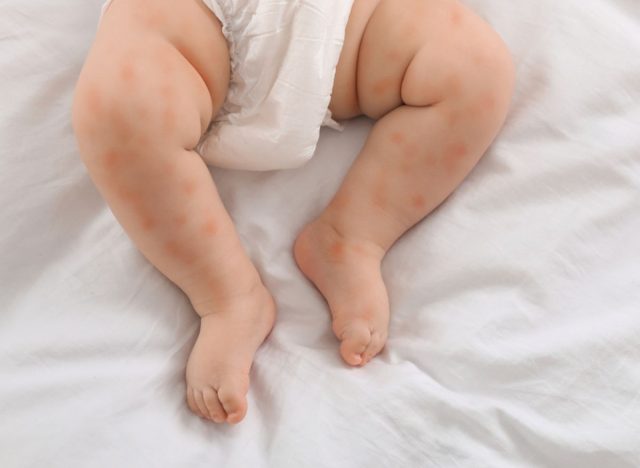

While you’re starting to bring the long list of allergens into your child’s diet, you should be aware of what it looks like when they’re having an allergic reaction to a new food. This is especially crucial since there are both mild and severe reactions when it comes to food allergies.
“The biggest thing that a baby could have that would make you think they might have allergies is if they have skin rashes called eczema or atopic dermatitis,” Dr. Sicherer says. These rashes are itchy and might occur on a baby’s face, arms, legs, chest, and/or back.
While it’s believed that babies who experience eczema in their first few months of life may be more prone to allergy, Dr. Sicherer explains, “it doesn’t mean they are experiencing a food allergy, it just means that they’re someone that might go on to have a food allergy.”
Other common and more subtle allergy symptoms, according to Dr. Sicherer, are often going to be gut-related or visually obvious within a short time period after the baby eats these new foods. These can be anything from having diarrhea or blood in the stool, vomiting, hives, swelling, rashes, or even signs the baby isn’t growing enough.
On the more severe side, you’re going to see an extreme case of eczema or atopic dermatitis, or the child may have trouble breathing, cough or wheeze, or turn pale or blue in the face. However, this is not to sound the alarms! “Those are not going to be common for babies being introduced to these foods first off,” Dr. Sicherer says.
READ RELATED: I Tried Texas Roadhouse for the First Time Ever—Here's What I Loved
“If the baby doesn’t really show any signs of allergy—no eczema or anything else—there’s no strong reason to expect there’s going to be a problem,” he explains.
According to Main Street Pediatrics, many severe reactions will typically happen about 10-15 minutes after eating the food, but some mild reactions could take a few hours to begin to show up.
Now, if your infant is trying allergen foods for the first time and you are seeing any of these signs (mild or severe), immediately stop! Take a deep breath and treat these reactions or symptoms like you would any other condition—give your child (allergy) medication following the advice of your doctor and visit your doctor for assistance and an evaluation if needed.


When getting ready to share these new foods with your baby, it’s best to keep in mind that, “allergens are essentially the same as any other food, [and] they still have to be given in a way that a baby isn’t going to choke on it,” says Dr. Sicherer.
On average, the first foods fed to babies in America are normally ones like grains or oats (mashed up without any chunks) and pureed food in jars. These are almost always single-ingredient foods or vegetables—such as oatmeal, squash, peas, or applesauce—and can remain the initial solids you decide to give your infant, before stepping into the realm of allergens.
When allergy-related foods come into the picture (and with any other new food), Dr. Sicherer recommends smoothing out choking hazardous components into warm water to make a sauce or liquidy paste (apple sauce is a great example of this!).
“Tree nuts are real hard,” he explains. But if you’re really adamant about adding them to your infants’ diet as soon as they’re ready, then it’s best to “have it in forms that are going to be baby-safe. That would be made into butters that can be smoothed out, for example, or flours.”
If you’re looking for something simple to start within the allergens family, try some soft cheeses, yogurt, or eggs. “Eggs could be pretty easy,” Dr. Sicherer claims, while “babies should not eat raw egg, you certainly could make scrambled egg and mash it up into small bits.”
Another great trick is mixing an allergen food into baked goods, specifically for introducing wheat, milk, or soy. Even the slightest bit can go a long way, as an infant only needs to consume a small amount of an allergen food to be considered as exposure.
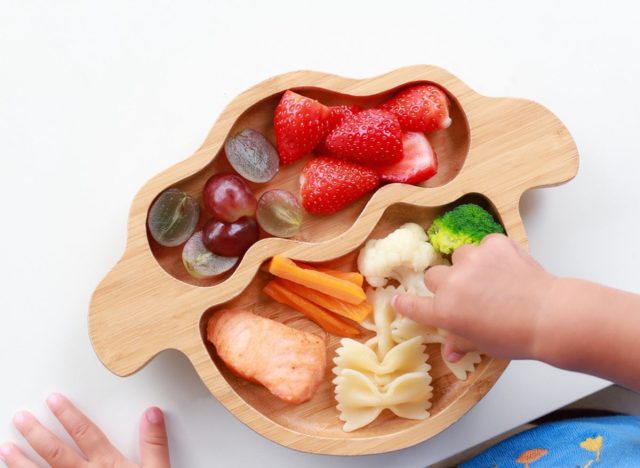

Even though it’s frightening not to know the outcome, it’s still not a great idea to postpone the introduction of allergens to babies. One way to create this safe pattern where the immune system is more accepting of foods, is for your child to “have a diverse diet,” Dr. Sicherer explains, and it’s “been seen to help prevent food allergies.”
“The more things the baby can eat, the merrier,” he says. Doctors and researchers are more confident than ever that early exposure to allergens, as well as all foods in general, is even better for the child’s gut and immune system because they’ll learn to digest more (including “worry foods”) in a normal and healthy manner.
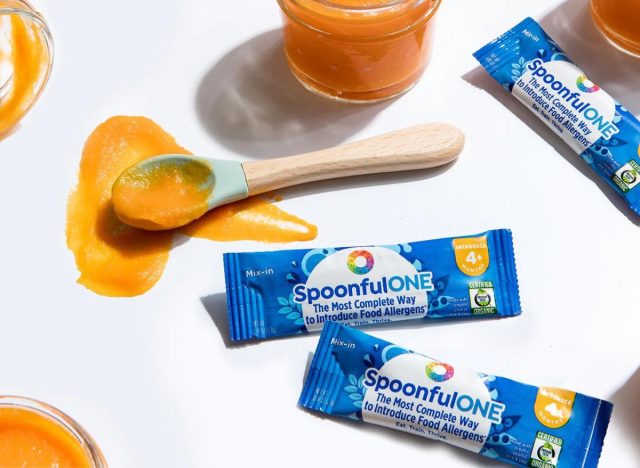

As you start your search for pureed foods and other solids for your child to try to diversify their diet, there’s a new product on the market that might be of interest to you. Baby food companies are coming out with products made specifically with the intention of serving allergens into an infant’s diet as early as possible, as well as keeping them a part of their everyday foods going forward.
They’re all “baby-safe, pre-made, measured products,” Dr. Sicherer says. Certain baby food companies claim that they are good “specifically for prevention of allergy types,” he explains, but they’re not FDA approved to do so. Spoonful ONE, an example of this baby food manufacturer, sells powdered mix-in options and dissolvable puff snacks that are meant to introduce 16 different allergen foods.
These introductory products that outwardly claim to be allergy preventative are more expensive than other baby foods, but “there’s a choice in this situation between the convenience versus the cost,” Dr. Sicherer explains. If you use most all other baby food company products, you’ll have to use your own blending method, measure a good quantity, and then it will be ready to serve.
RELATED: 5 Healthy Fast-Food Kids Meals for Busy School Days
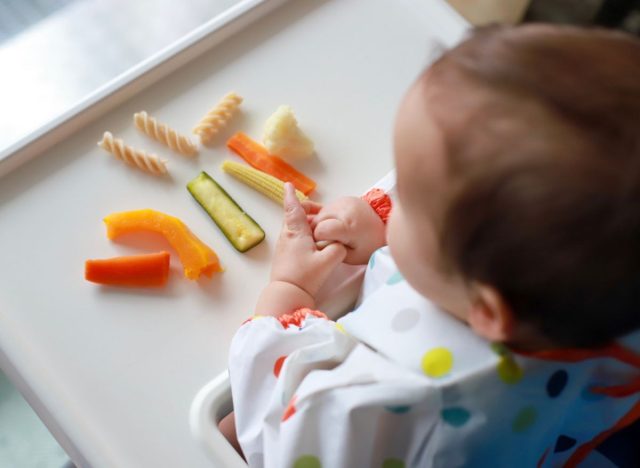

In the very beginning, infants need to be consuming either breastmilk or formula as their main source of food and nutrients. “Cow’s milk is not appropriate for an infant,” says Dr. Sicherer, “but if the baby’s going to have formula that’s made out of cow’s milk, that’s okay, because it’s made for babies”
Then, once your child hits the six-month milestone (or older) and has moved on to more solid foods, you might want to know other ways allergens can make it onto your little one’s plate. Now, to be clear, there’s no need to worry about these foods if you’re baby hasn’t shown signs of allergy quite yet, but they’re good to keep in mind if you begin seeing allergy signs (discussed above) come up shortly after consumption.
Normally, there’s a pretty solid understanding that milk, cheese, fish, and nut-butters in their standard form are all allergen foods. On the contrary, there may be some other foods that are not as commonly known to have an allergen-related ingredient. Groceries such as pasta, (which is made out of wheat), breaded chicken (which usually has some sort of egg in the breading), certain breads (which may have a milk component), and some thick sauces (inexplicitly could have peanuts).
You should also stay aware of any type of cross-contamination situations that could arise. Dr. Sicherer, explains, “You’re making a chicken broth, but you’re also making a cream soup next to that, and you put the spoon from the cream soup into the non-milk soup, then you would have cross contacted the soup that wasn’t supposed to have milk in it.”
Source:











